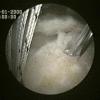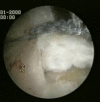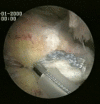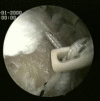The Roman Bridge: a "double pulley - suture bridges" technique for rotator cuff repair
- PMID: 18088422
- PMCID: PMC2235854
- DOI: 10.1186/1471-2474-8-123
The Roman Bridge: a "double pulley - suture bridges" technique for rotator cuff repair
Abstract
Background: With advances in arthroscopic surgery, many techniques have been developed to increase the tendon-bone contact area, reconstituting a more anatomic configuration of the rotator cuff footprint and providing a better environment for tendon healing.
Methods: We present an arthroscopic rotator cuff repair technique which uses suture bridges to optimize rotator cuff tendon-footprint contact area and mean pressure.
Results: Two medial row 5.5-mm Bio-Corkscrew suture anchors (Arthrex, Naples, FL), which are double-loaded with No. 2 FiberWire sutures (Arthrex, Naples, FL), are placed in the medial aspect of the footprint. Two suture limbs from a single suture are both passed through a single point in the rotator cuff. This is performed for both anchors. The medial row sutures are tied using the double pulley technique. A suture limb is retrieved from each of the medial anchors through the lateral portal, and manually tied as a six-throw surgeon's knot over a metal rod. The two free suture limbs are pulled to transport the knot over the top of the tendon bridge. Then the two free suture limbs that were used to pull the knot down are tied. The end of the sutures are cut. The same double pulley technique is repeated for the other two suture limbs from the two medial anchors, but the two free suture limbs are used to produce suture bridges over the tendon, by means of a Pushlock (Arthrex, Naples, FL), placed 1 cm distal to the lateral edge of the footprint.
Conclusion: This technique maximizes the advantages of two techniques. On the one hand, the double pulley technique provides an extremely secure fixation in the medial aspect of the footprint. On the other hand, the suture bridges allow to improve pressurized contact area and mean footprint pressure. In this way, the bony footprint in not compromised by the distal-lateral fixation, and it is thus possible to share the load between fixation points. This maximizes the strength of the repair and provides a barrier preventing penetration of synovial fluid into the healing area of tendon and bone.
Figures









Similar articles
-
The low-profile Roman bridge technique for knotless double-row repair of the rotator cuff.Arch Orthop Trauma Surg. 2011 Mar;131(3):357-61. doi: 10.1007/s00402-010-1203-3. Epub 2010 Nov 10. Arch Orthop Trauma Surg. 2011. PMID: 21063885
-
Soft tissue tenodesis of the long head of the biceps tendon associated to the Roman Bridge repair.BMC Musculoskelet Disord. 2008 Jun 4;9:78. doi: 10.1186/1471-2474-9-78. BMC Musculoskelet Disord. 2008. PMID: 18533031 Free PMC article. Review.
-
Two Techniques for Treating Medium-Sized Supraspinatus Tears: The Medially Based Single-Row Technique and the Suture Bridge Technique.JBJS Essent Surg Tech. 2021 Jun 8;11(2):e20.00004. doi: 10.2106/JBJS.ST.20.00004. eCollection 2021 Apr-Jun. JBJS Essent Surg Tech. 2021. PMID: 34277130 Free PMC article.
-
The double-pulley technique for double-row rotator cuff repair.Arthroscopy. 2007 Jun;23(6):675.e1-4. doi: 10.1016/j.arthro.2006.08.016. Epub 2007 Jan 5. Arthroscopy. 2007. PMID: 17560485
-
Arthroscopic transosseous rotator cuff repair.Med Sport Sci. 2012;57:142-152. doi: 10.1159/000328900. Epub 2011 Oct 4. Med Sport Sci. 2012. PMID: 21986052 Review.
Cited by
-
Scaffolds in tendon tissue engineering.Stem Cells Int. 2012;2012:517165. doi: 10.1155/2012/517165. Epub 2011 Dec 11. Stem Cells Int. 2012. PMID: 22190961 Free PMC article.
-
Effect of dihydrotestosterone on cultured human tenocytes from intact supraspinatus tendon.Knee Surg Sports Traumatol Arthrosc. 2010 Jul;18(7):971-6. doi: 10.1007/s00167-009-0953-3. Epub 2009 Oct 27. Knee Surg Sports Traumatol Arthrosc. 2010. PMID: 19859693
-
The bioinductive collagen implant yields positive histological, clinical and MRI outcomes in the management of rotator cuff tears: A systematic review.Knee Surg Sports Traumatol Arthrosc. 2025 Mar;33(3):1070-1090. doi: 10.1002/ksa.12429. Epub 2024 Sep 5. Knee Surg Sports Traumatol Arthrosc. 2025. PMID: 39234682 Free PMC article.
-
Advances in meniscal tissue engineering.Stem Cells Int. 2012;2012:420346. doi: 10.1155/2012/420346. Epub 2011 Oct 26. Stem Cells Int. 2012. PMID: 25098366 Free PMC article. Review.
-
Biomechanics of an interlinked suture anchor rotator cuff repair in a human cadaveric model.JSES Open Access. 2019 Apr 26;3(2):70-76. doi: 10.1016/j.jses.2019.02.002. eCollection 2019 Jul. JSES Open Access. 2019. PMID: 31334432 Free PMC article.
References
-
- Apreleva M, Ozbaydar M, Fitzgibbons PG, Warner JJ. Rotator cuff tears: the effect of the reconstruction method on three-dimensional repair site area. Arthroscopy. 2002;18:519–526. - PubMed
-
- Lo IK, Burkhart SS. Double-row arthroscopic rotator cuff repair: re-establishing the footprint of the rotator cuff. Arthroscopy. 2003;19:1035–1042. - PubMed
-
- Park MC, Elattrache NS, Ahmad CS, Tibone JE. "Transosseous-equivalent" rotator cuff repair technique. Arthroscopy. 2006;22:1360.e1–1360.e5. - PubMed
MeSH terms
LinkOut - more resources
Full Text Sources

